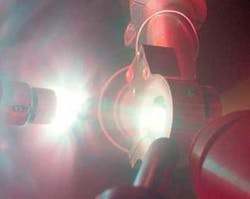Diamond anvils and laser pulses may create pressures comparable to those at Jupiter’s core
Combining a diamond anvil with kilojoule-level laser pulses, researchers at the University of California, Berkeley (Berkeley, CA), Lawrence Livermore National Laboratory (LLNL; Livermore, CA), New Mexico State University (Las Cruces), and France’s Atomic Energy Commission (Gif-sur-Yvette, France) are aiming to create laboratory pressures equal to those in the cores of supergiant planets like Jupiter. Today, diamond anvils (without laser pulses) reach pressures of 5 million atmospheres, slightly higher than at the Earth’s core, while laser shock waves (without anvils) achieve pressures of tens of millions of atmospheres.
Using the 30 kJ ultraviolet Omega Laser at the University of Rochester’s Laboratory for Laser Energetics, the researchers create shock waves in the anvil’s pressure area to create pressures of around 10 million atmospheres. The method allows independent tuning of temperature and density of the sample-difficult to achieve with laser shock waves alone. However, LLNL researcher Raymond Jeanloz (who helped develop diamond-anvil cells 25 years ago) and colleagues hope to use the 2 MJ laser at LLNL’s National Ignition Facility along with anvils to create pressures of greater than a billion atmospheres. Contact Jeanloz at [email protected].
